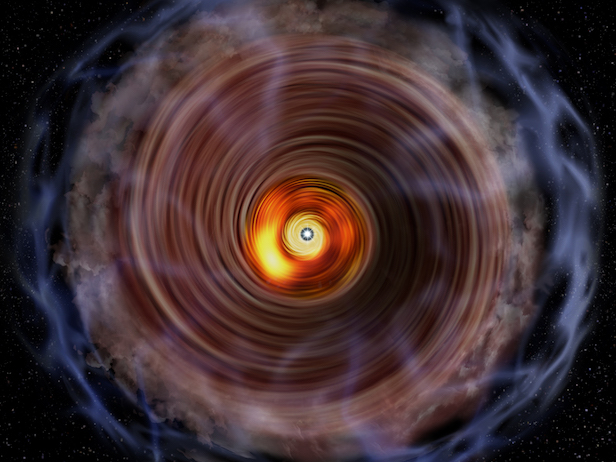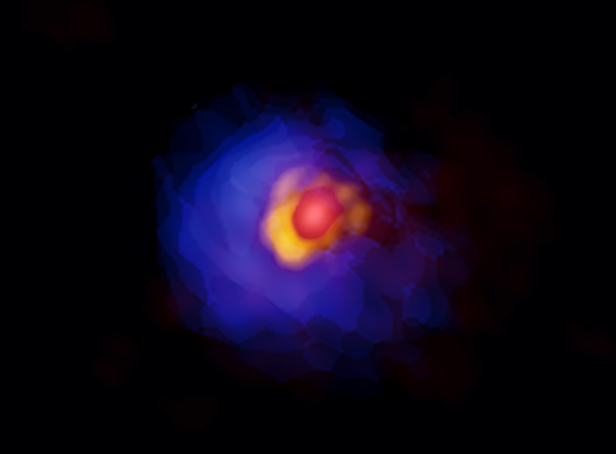Solved! How the universe’s biggest stars become massive
Astronomers have obtained the first detailed face-on view of a gaseous disc feeding the growth of a massive baby star

Artist’s impression of the gaseous disc and envelope around the massive protostar G353.273+0.641. Image credit: National Astronomical Observatory of Japan
Astronomers have obtained the first detailed face-on view of a gaseous disc feeding the growth of a massive baby star. They found that it shares many common features with lighter baby stars. This implies that the process of star formation is the same, regardless of the final mass of the resulting star. This finding paves the way for a more complete understanding of star formation.
A protostar, a baby star still in the process of forming, is fed by a surrounding disc of gas falling towards the centre. The details of the process, such as why stars form with a wide range of masses, are still unclear. Low mass stars are being formed in the vicinity of the Solar System, allowing astronomers to see the process up-close. On the other hand, massive protostars are rare, and even the nearest are located quite far away from us.
Kazuhito Motogi, an assistant professor at Yamaguchi University, Japan, and his team used the Atacama Large Millimeter/submillimeter Array (ALMA) to observe a massive protostar called G353.273+0.641 (hereafter G353). Located 5,500 light years away in the constellation Scorpius, G353 has a mass ten times larger than the Sun, and is still growing. It is a unique target among massive protostars because we can see its gaseous disc from straight above. ALMA has revealed detailed views of several other massive infant stars, however, most of them are in edge-on configurations, making it difficult to see the inner regions of the discs.

ALMA image of the massive protostar G353.273+0.641. Emission around the central protostar, disc, and gaseous envelope are shown in red, yellow, and blue. Image credit: ALMA (ESO/NAOJ/NRAO), Motogi et al.
ALMA observations captured a rotating disc around G353 with a radius eight times larger than the orbit of Neptune. This sounds huge, but it is one of the smallest discs yet found around a massive protostar. ALMA also found that the disc is surrounded by an envelope of gas three times larger than the disc.
“We measured the gas infall rate from the outer envelope to the inner disc,” says Motogi. “This helps us to estimate the age of the baby star. Surprisingly it is only 3,000 years old, the youngest among known massive protostars. We are witnessing the earliest phase of the growth of a giant star.”
Interestingly, the disc is not uniform; the south-eastern side of the disc is brighter than other parts. This is the first time astronomers have seen an asymmetric disc around a massive protostar. The team also found that the disc is highly unstable and going to fragment. The uneven disc might be caused by this instability. These features are often seen around smaller protostars, suggesting that the essential physical processes are the same in low-mass and high-mass star formation.
“Previous studies had implied that the formation process might be different for stars of different masses,” says Motogi. “Our new observations show the similarity. This is an important step to understand how massive protostars gain mass from the surroundings.”
Keep up to date with the latest news in All About Space – available every month for just £4.99. Alternatively you can subscribe here for a fraction of the price!




